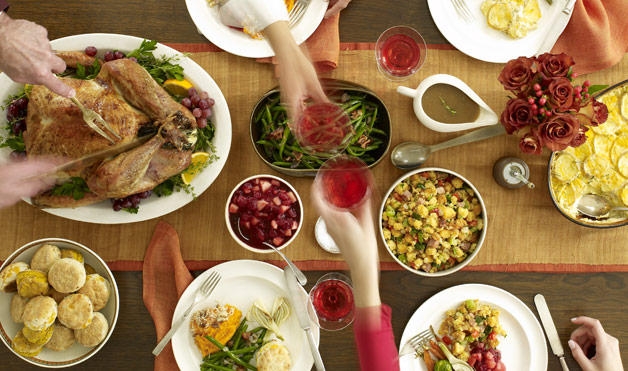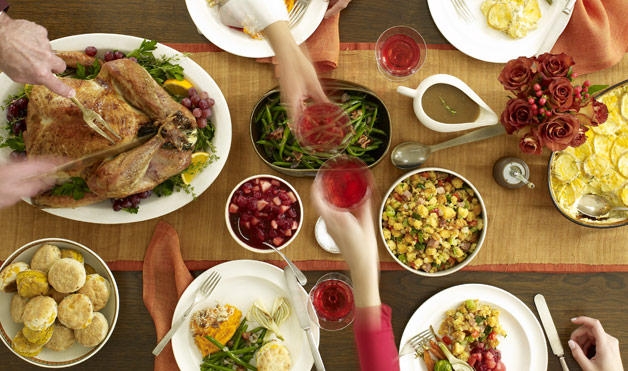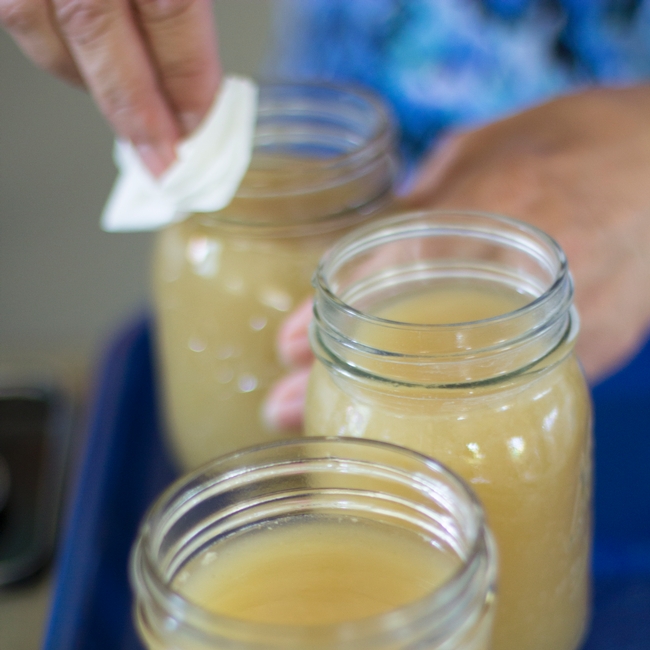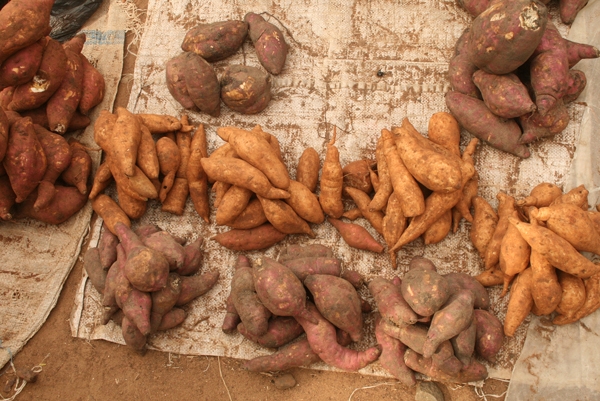Posts Tagged: Thanksgiving
Have a Happy Thanksgiving without unzipping
- Portion control: Thanksgiving is about choices. Think about which dishes you don't mind skipping, and plan to fill your plate only once. It's easy to get carried away going back for second and third helpings.
- Fruits: Get your serving of fruit with a fruit-based dessert. Baked apples, poached pears and fresh figs are a few festive options.
- Grains: Use whole grain or 100 percent whole wheat bread for a stuffing rich in fiber.
- Protein: Serve yourself 3 ounces of roasted turkey or a portion the size of your palm. Skip the fat by removing the skin on your turkey before eating it. Go easy on the gravy.
- Vegetables: Choose vegetable side dishes that include roasted or cooked vegetables, and skip the creamy sauces and added fat. Instead, season vegetables with fresh herbs to add flavor.
- Dairy: Try non-fat Greek yogurt as a healthier topping for side dishes than sour cream or butter.
- Don't forget to be active. After the holiday meal, go for a walk, bike ride or play football with the family.
Not sure what to do with your leftovers? Reinvent your Thanksgiving feast with these quick and easy one-sentence leftover recipes.
- Cranberry smoothies
Whirl cranberries with frozen low-fat yogurt and orange juice. - Crunchy turkey salad
Toss cubed turkey with celery, apples, and light mayo with shredded spinach. - Stuffing frittata
Mix stuffing with egg and cook thoroughly, pancake-style. - Turkey berry wrap
Wrap sliced turkey, spread with cranberry sauce and shredded greens in a whole wheat tortilla.
Recipe source: www.eatright.org
Author: Melissa Tamargo
A simple holiday how-to: homemade turkey stock
Feeling the pressure of holiday leftovers? There are simple ways to preserve holiday leftovers using extra turkey scraps and bones, while preventing tryptophan overload.
Any connoisseur of meat or vegetable stocks would tell you that the flavor of homemade can't be matched with something store bought. Homemade stock is easy to prepare and can be preserved for future use by simply freezing or using a pressure canner. Consider using homemade turkey stock for soups or as a cooking liquid for quinoa. A good stock adds a sublime flavor to any cooked grain.
Quick and easy homemade turkey stock
To prepare homemade turkey stock, place cooked turkey bones into a large stockpot and cover with water. (It's fine to still have some meat attached to the bones, it only adds to the flavor.) Cover the pot and bring the mixture to a boil, reduce heat and simmer the slurry for 30-45 minutes.
Once simmered, remove bones and let stock cool. Fat will rise to the top of the stock. Use a spoon to remove fat leaving only the turkey-infused liquid. At this point, strain stock through cheesecloth to remove any leftover herbs or bits of meat. This step is optional – many prefer to keep meat trimmings in the stock. Once the fat is removed and the stock is strained, the next step is to preserve the stock for future use.
Preserving turkey stock
To freeze, simply seal the stock in a freezer-proof container, freezer gallon storage bags work great for this method. Clearly label and date the storage bag or container – remember that this method has a freezer storage life of 6 months. If freezing the stock in storage bags, it is best to lay the bags on a cookie sheet and freeze flat for easy storage.
For a longer shelf life, consider pressure canning your stock which will preserve the delicious turkey stock for up to 12 months in your pantry.
Simply bring your stock back up to a boil and fill sterilized jars, leaving one inch of headspace. Clean rims of the jars before putting on the two part lid, tighten the lid rings only to “finger tight.” Process in a pressure canner using guidelines available from the National Center for Home Food Preservation.
If you are intrigued by pressure canning or need a refresher course, take a class from your local UC Master Food Preserver Program before getting started.
New reason to give thanks for the sweet potato
What if you could significantly improve the nutritional quality of your diet, just by switching one of the vegetables you eat every day?
In parts of Africa, some people are doing just that by switching from yellow or white sweet potatoes to orange-fleshed varieties.
That orange color signifies the potato’s beta-carotene content, which our bodies convert to vitamin A. Vitamin A deficiency is the leading cause of preventable blindness in children and is crucial to the survival of children and pregnant women, according to the World Health Organization.
So scientists and organizations who are working to increase vitamin A in African diets have turned to the orange-fleshed sweet potatoes as a potential solution, wherever light-colored sweet potatoes loom large.
With funding from the U.S. Agency for International Development, Horticulture CRSP is working in Ghana to strengthen the entire value chain of orange-fleshed sweet potato — from farmers and food processors, to markets and consumers.
Though Horticulture CRSP is led by UC Cooperative Extension’s Elizabeth Mitcham at UC Davis, this project includes a team of international researchers with experts from Tuskegee University, Penn State and Ghana University. Together, they are working to:
- provide farmers with germplasm and best management practices
- teach women entrepreneurs to process orange-fleshed sweet potatoes into bread flour, purees and dehydrated chips
- formulate a weaning food for babies that incorporates orange-fleshed sweet potatoes with other, traditional foods
Find out more about this Horticulture CRSP sweet potato project (including a 2-minute video).
Did you know? In 2011 California was the second largest producer of sweet potatoes in the United States, with North Carolina leading the way (source). Find out more in this related ANR News Blog post or from the UC Vegetable Research and Information Center.
Eat, drink and be merry this holiday season…and pay for it later?
December is a very festive time of year. For most of us, it’s an entire month filled with holiday parties, family gatherings and other social events, typically centered around one thing - food. It’s easy to get caught up in the excitement of the holiday season. This is the time of year when tempting holiday treats trump our usual sensible meals, healthy habits and workout regimens. Stress can also play a prominent role during the holidays as many of us get overwhelmed by the hustle and bustle of the season and forgo our normal routines. We often justify an entire month of overindulging our sweet tooth and allowing ourselves second (and third!) helpings by vowing to eat healthy and exercise it off in the New Year. What can be the harm in that?
Well, according to research published in the August issue of Nutrition & Metabolism, we could see the ill effects of our short-term holiday indiscretions for years to come. The researchers had 18 subjects increase their calorie intake by 70 percent over a 4-week period of time and limit their physical activity to less than 5,000 steps per day. Does this sound like the all-too-familiar Thanksgiving through New Year's free-for-all to you? Not surprisingly, the subjects gained, on average, 14 pounds during this short-term intervention period. Six-months later, most of them lost weight. The startling results were discovered, however, at the one-year and 2 ½-year follow-ups. The intervention participants had increased body weight and fat mass compared to their baseline measurements. More telling is the fact that the control group – the participants who didn’t go on the four-week eating binge at the beginning of the study - did not experience any weight gain after 2 ½ years. The researchers have left us wondering whether over-eating in the short-term can have lasting effects on our waistlines for years to come.
Clearly, more research is necessary in this area, but before you go spending the entire month of December throwing sensible eating habits and physical activity to the wind, you might want to think twice!
Tips to stay healthy during the holiday season:
Don’t give yourself a “pass” for the month of December. It’s important to keep portion sizes in check and to limit foods that are high in added fat, sugar and salt. It’s also important to maintain your regular physical activity routine. If you’ve been meaning to incorporate more physical activity into your daily routine, no need to wait until Jan. 1 to start. Now is as good a time as ever to get moving. Exercise can help alleviate some of the added stress brought on by the holidays and boost your holiday cheer through the exercise-induced endorphins.
The USDA offers a number of healthy recipes and tips on the SNAP-ED Connection website to help get you through this merry season unscathed by traditional holiday fare.
Do you live in the LA area? Join LA County Cooperative Extension on Friday, Dec. 10 to get great tips on how to have a healthy holiday season. The general public is invited to attend and will learn about healthier options to traditional holiday recipes, ways to stay active during the holiday season, and how to make healthy choices during a time when many of our budgets are stretched to the limit.
For more information about this event, please contact Los Angeles County Nutrition, Family & Consumer Sciences Advisor Brenda Roche at bkroche@ucdavis.edu (323-260-3299) or visit our website calendar for more information.

Don't over induldge, even during the holidays.
Holiday food safety
Why is there a turkey in the garage?! If you’ve ever found yourself asking any variant of this question, trust us - you’re going to want to read on.
As the holiday season approaches, we begin to think about spending time with our families, enjoying one another’s company over the many feasts that accompany special days. While we may set aside mindful eating during the holiday season, we should not set aside food safety.
In many families, once the holiday meal is served it may sit on the table for 2-3 hours while people come and go, “picking” from the various serving dishes. The most creative food safety flub goes to a family member who thaws her holiday turkey in her garage. Her justification of this practice? “I haven’t hurt anyone yet!”
With respect for time-honored traditions, might we suggest that this festive time of giving and sharing SHOULD NOT include sharing foodborne illness by forgetting food safety measures? In many California counties, we may still have some heat lingering late into the November month. How much harm can the garage thawing method, or “GTM” if you will, really have? After all, we will be cooking it appropriately right? Wrong!
A few turkey thawing tips:
- If thawing your turkey in the refrigerator; plan for 24 hours per 4-5 pounds of turkey.
- Place the turkey into a container to avoid contaminating other foods.
- If thawing your turkey in cold water; plan for 30 minutes per 1 pound of turkey. Remember to change the water every 30 minutes.
- If thawing your turkey in the microwave;
follow the manufacturer guidelines.
- A turkey thawed in cold water or in the microwave must be cooked immediately.
(Photo: USDA)
Cooking your turkey properly ensures that all harmful bacteria have been destroyed.
Cooking time ranges from 2¾ hours to 5¼ hours depending on size and whether the turkey is stuffed. To check the temperature of a properly cooked turkey, one should insert the thermometer into the innermost part of the thigh and wing as well as the thickest part of the breast; proper temperature should read 165 degrees. Once all parts have reached this minimum temperature, it is safe to eat, even if parts should remain pink. Stuffing should read 165 degrees when properly cooked as well.
Here are a few tips to keep your foods safe when storing leftovers:
- Cut turkey or other meats into smaller pieces. Store stuffing separately.
- Divide large quantities of food items into smaller portions before storing.
- Store different food items separately.
- Turkey that is stored in the refrigerator can be held for 3-4 days; reheat to 165 degrees.
- Frozen turkey can be stored for 2-6 months; reheat to 165 degrees.
Enjoy your holiday feast and be sure to keep your foods safe!
These tips and more can be found at http://www.fsis.usda.gov/.
Blog contributors: Connie Schneider, Ph.D., R.D., Laurin Herrera, CSUF Dietetic Intern, & Shelby MacNab, Nutrition Program Manager








